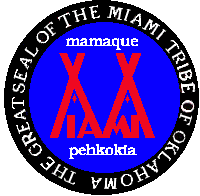|
|
Canku Ota |
|
|
(Many Paths) |
||
|
An Online Newsletter Celebrating Native America |
||
|
December 28, 2002 - Issue 77 |
||
|
|
||
|
Miami U., Tribe Work to Save Culture |
||
|
by Randy McNutt The
Cincinnati Enquirer
|
||
|
|
 OXFORD,
OH - Three centuries of American Indian culture is flowing through this
northern Butler County city now that Miami University is the central
repository for the Miami Indian tribe. OXFORD,
OH - Three centuries of American Indian culture is flowing through this
northern Butler County city now that Miami University is the central
repository for the Miami Indian tribe. Its historical, cultural and linguistic resources - the essence of a people - are back on land once inhabited by Indian tribes, including the Miamis. The tribe, now based in Miami, Okla., and the university, which takes its name from the tribe, reached a historic agreement this month to establish the Myaamia Collection at Miami University. (Myaamia is the Miami word for Miami.) The agreement is believed to be the first of its kind in the nation, one that could serve as a model for other tribes and universities, said Daryl Baldwin, a linguist and the director of the Myaamia Project for Language Revitalization. "It was a big step for the Miami Nation to move a portion of its language reclamation efforts to an academic setting," Mr. Baldwin said. "This opportunity has provided college-level students an opportunity to work directly with language and cultural efforts, and has provided the Miami with resources that directly benefit their reclamation efforts."
Collection materials - such items as paper records, photographs and maps - will be kept in the university's libraries. Cultural and patrimonial objects, such as religious items, will be kept at Miami's art museum. The school will also keep duplicates of tribal records. "We are happy to be a party to such an agreement between an institution of higher learning and a native sovereign nation," said Floyd Leonard, chief of the Miami Tribe. The Miamis lived in Ohio before U.S. forces defeated a warrior coalition at the Battle of Fallen Timbers near Toledo in 1794. After the Treaty of Greenville was signed, most of the tribe went to Indiana. By 1846, many had been moved to Kansas, and by 1867 to Oklahoma. As the Miamis interacted with the general population, the use of their own language declined. Chief Leonard, who is in his mid-70s, said the tribe must try to save its language now or risk losing it forever. In 1995, the tribe started a language revitalization program with the help of David Costa of the University of California at Berkeley. Since then, the Miamis have developed interactive software, language lessons and tapes, and language and cultural camps to help save their native tongue and culture.
|
||||||||||||
|
|
||
|
|
||
| Canku Ota is a free Newsletter celebrating Native America, its traditions and accomplishments . We do not provide subscriber or visitor names to anyone. Some articles presented in Canku Ota may contain copyright material. We have received appropriate permissions for republishing any articles. Material appearing here is distributed without profit or monetary gain to those who have expressed an interest. This is in accordance with Title 17 U.S.C. section 107. | ||
|
Canku Ota is a copyright © 2000, 2001, 2002 of Vicki Lockard and Paul Barry. |
||
 |
 |
|
|
The "Canku Ota - A Newsletter Celebrating Native America" web site and its design is the |
||
|
Copyright © 1999, 2000, 2001, 2002 of Paul C. Barry. |
||
|
All Rights Reserved. |
||
 The
official collection will serve as the nation's primary resource on the
Miami Indians, accessible to the Miami tribal community, academic researchers
and the general public, said university spokeswoman Susan Meikle.
The
official collection will serve as the nation's primary resource on the
Miami Indians, accessible to the Miami tribal community, academic researchers
and the general public, said university spokeswoman Susan Meikle.
